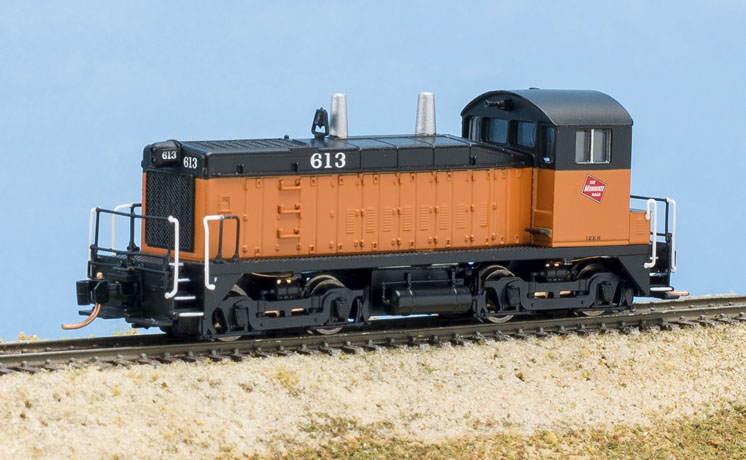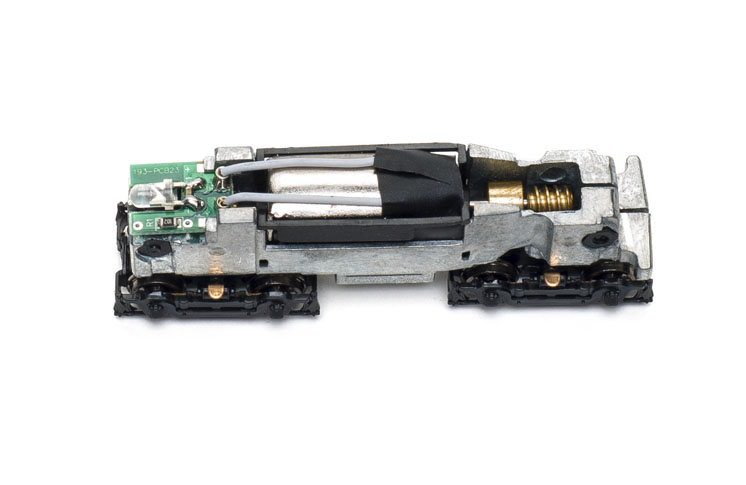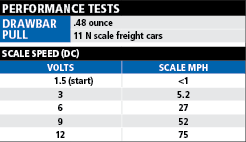The prototype. Electro-Motive Division built 1,024 SW1200s in the United States and Canada between January 1954 and May 1966 for 81 customers in North and South America. Another 815 nearly identical SW9s were built between February 1951 and December 1953.
These 1,200-hp locomotives featured 12-cylinder 567-series two-stroke diesel engines. SW9s and early SW1200s look identical, with two exhaust stacks and six louvers on the battery boxes behind the cab. SW1200s built after March 1955 have five louvers on their battery boxes.
Many options were available. Most locomotives had AAR Type A trucks, but EMD Flexicoil trucks were available. Different headlight and number box combinations were built, and several fuel tank sizes were offered. The largest, 1,200 gallons, required the air tanks to be mounted atop the hood.
Since these locomotives were also used as light road switchers, m.u. connections and the related drop steps were popular options. A few locomotives were even equipped with dynamic brakes.
These engines led long lives, with some still working short lines today. BNSF Ry. was still operating its inherited units into the mid-2000s.
To remove the shell, first pull off the fuel tank casting. Be careful with the fine air-piping details. Pull on the bottom of the frame casting to remove the shell from the frame. The cab end of our sample was reluctant to move, so I tried pulling on the truck.
This resulted in the sideframes and wheelsets separating from the truck, which at least allowed me to slip a hobby knife between the frame and shell to lever the pieces apart. The truck parts snapped back together.
Be aware of the metal wipers attached to the bottom of the sill on the shell. They conduct electricity from the trucks to the frame halves and are fragile. This also means the model won’t move with the body detached.
Under the shell is the typical N scale die-cast metal split-frame chassis. A five-pole, skew-wound open frame motor is trapped between the halves. At the cab end, a brass flywheel/worm gear combination drives the rear truck. Another worm gear drives the front truck.
Mounted above the front truck is a small printed-circuit (PC) board carrying a light-emitting diode (LED) for the headlight. The motor power wires are plugged into this PC board as well. The rear light isn’t illuminated.
Instructions on the Digitrax and TCS websites (www.digitrax.com and www.tcsdcc.com, respectively) show the relatively simple (no soldering) installation procedure for adding a DCC motor-only decoder. Adding sound would be a more challenging project, as there’s hardly any room for a speaker.
The body shell is molded in three pieces: the cab, hood, and walkways and steps. Micro-Trains knuckle couplers are mounted to the body shell. The model matches drawings printed in Model Railroader Cyclopedia: Vol. 2, Diesel Locomotives (Kalmbach Publishing Co., out of print). The six louvers on the battery boxes make this an early SW1200.
The handrails are flexible plastic molded to near-scale dimensions. Separate bell, headlight, and horn castings complete the detail. The handrails and grab irons on the left side are molded on the long hood.
Our sample was decorated for the Milwaukee Road. The separation between the orange and black paint is sharp. The Milwaukee Road logo on the cab side and the road number and unit class are all printed clearly. The cab side windows have silver painted frames, and the gaskets on the cab end windows are painted black.
Our test force meter registered .48 ounce, equivalent to 11 free-rolling N scale freight cars on straight and level track. I took the Walthers SW1200 to our Red Oak project layout to put it through its paces. The slow speed characteristics made it fun to switch the stockyard, grain elevators, and feed mill on the layout. The locomotive had no trouble with a 12-car train.
I also set up an Atlas N scale code 80 starter set with a pair of Snap Switches and 93⁄4″ radius curves. Again, the locomotive operated well and had no trouble pushing and pulling both a 40- and 50-foot boxcar around the track.
With the SW1200’s long production run and multitude of owners, plus its long life on the used locomotive market, these models are worthy of a place on any post-World War II N scale layout. If you model in N scale and you’re shopping for a switcher, give these a look.
Manufacturer
Wm. K. Walthers Inc.
5601 W. Florist Ave.
Milwaukee, WI 53218
www.walthers.com
Era: 1954 to 1985, as decorated
Road names: Milwaukee Road; Atchison, Topeka & Santa Fe; BNSF Ry.; Denver & Rio Grande Western; Elgin, Joliet & Eastern; Reading; and Southern Pacific. Two road numbers each, except Milwaukee Road and D&RGW (one road number each).
Features
• All-wheel drive and electrical pickup
• DCC-ready – can be equipped with TCS MT1500 or Digitrax DN-126M2 decoders, both sold separately
• Five-pole skew-wound motor
• Micro-Trains couplers, rear at correct height, front .040″ too high
• RP-25 metal wheels, in gauge
• Split die-cast metal frame
• Weight: 1.7 ounces
















